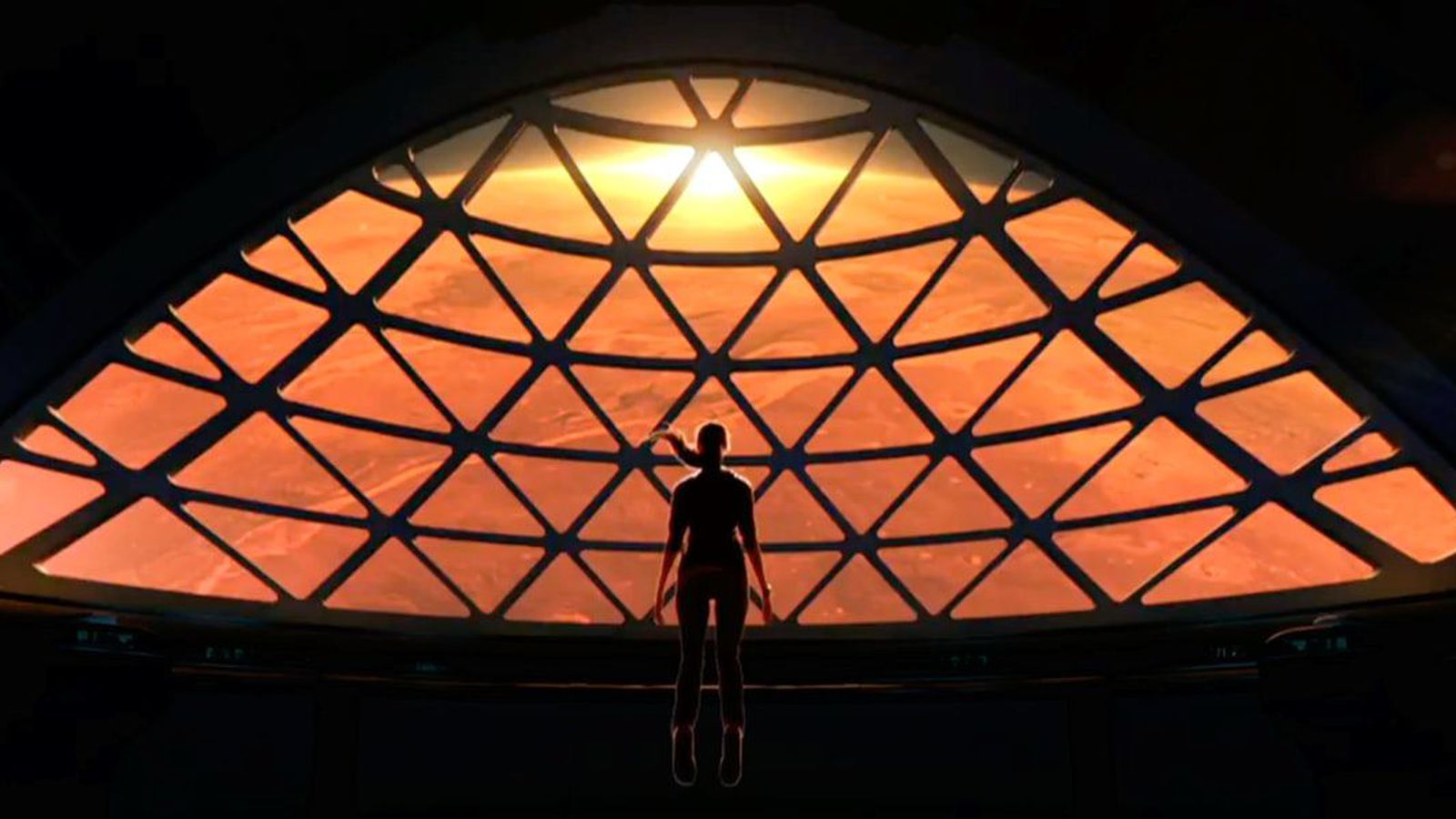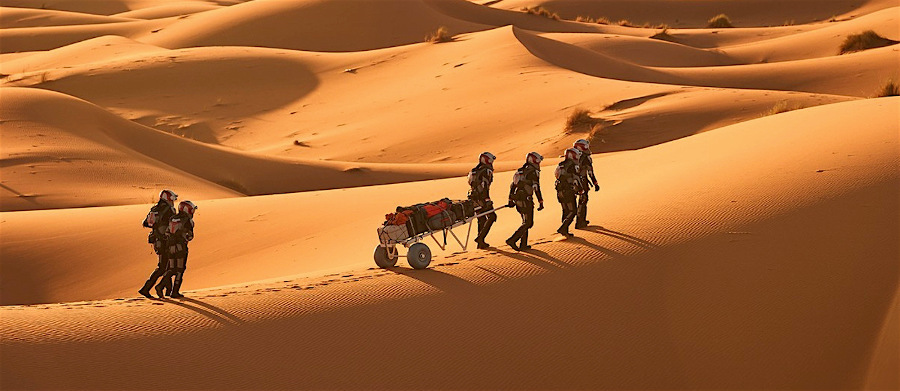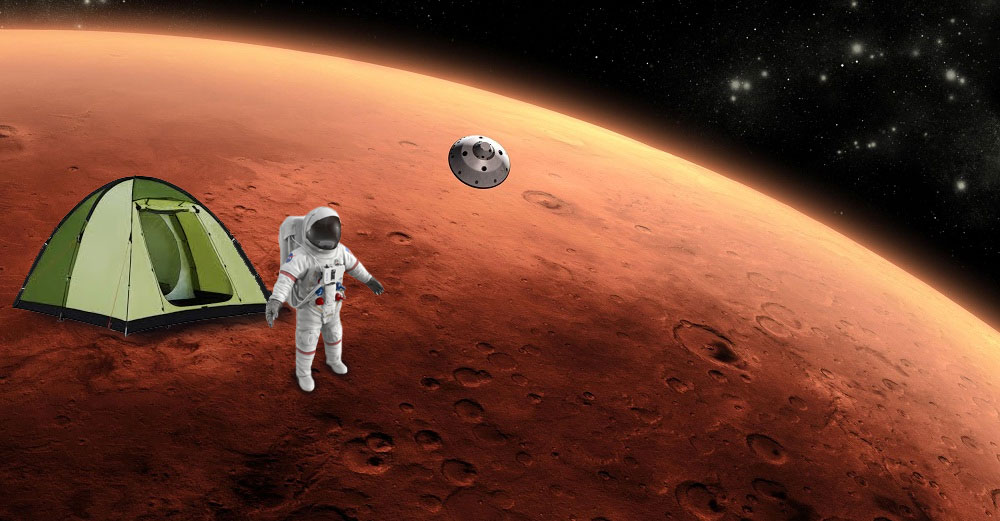Journey to Mars: what can happen with an astronaut on the way to the planet and on its surface

The new president of the United States, Donald Trump, contrary to expectations, did not cut NASA’s budget. In general, he left everything as is, signing a paper on the allocation of funds for the projects planned by the agency’s specialists. One of such projects is the flight of people to Mars and the landing of the first Marsonauts. This should happen no later than 2033.
While some scientists are developing reliable ways to get a man to Mars, others are studying the possible dangers that await astronauts and colonists on their way to a goal. There are many such dangers both on the way to the planet and on its surface. Recent studies by Wake Forest University's Center for Regenerative Medicine show that among other problems astronauts are threatened by leukemia and reduced immunity.
The results of earlier studies indicate that monsonauts will also be threatened with dementia with loss of memory from ionizing radiation. What problems might potential travelers to Mars face?
')
For example, a flight might end without really starting. To travel to Mars, you need a powerful carrier rocket, which has no analogues. It is developed almost from scratch. Despite the fact that the rocket and each of its elements are subjected to multiple complex checks, trouble still happens. Among the disasters of the newest history of cosmonautics, the explosion of the Falcon 9 launch vehicle is worth mentioning due to unforeseen damage to the wall of composite material separating the fuel from the oxidizer. According to Ilona Mask, the head of SpaceX, which developed this rocket, the accident was triggered by a series of coincidences, a series of failures of materials and equipment, which had no analogs yet. It is good that in this case only the equipment suffered, there were no people on board. Even more serious were the accidents of the USSR N-1 lunar rocket, all four tests of which were unsuccessful and accompanied by victims.
And what if unforeseen malfunctions had arisen aboard a launch vehicle heading for the first flight to Mars in the history of mankind? If there were victims, an extremely expensive rocket would have been destroyed and, most likely, a fat cross would have been put on the exploration of Mars in the near future.
Flight to mars
Radiation
Well, the rocket took off, there are no problems, people are heading for Mars. The path to the planet takes about 9 months in one direction, that is, it is the most real long-term space flight. And here man is threatened by radiation. The fact is that most of the ionizing radiation does not reach the Earth’s surface due to the magnetic field of our planet and its atmosphere. The higher, the greater the density of radiation. It is possible that cosmonaut Valentin Lebedev, who spent 221 days in Earth orbit, lost his sight due to radiation.
Experts compare the protection provided by the atmosphere from ionizing radiation with steel 1 meter thick. That is, only particles of the highest energy can break through such protection. As for the ISS or the spacecraft, the protection here is due only to the thickness of the hull walls, and this, at best, is a few centimeters. According to NASA experts, cosmic radiation can lead to the development of Alzheimer's disease.
Some experts believe that women on Mars is better not to fly. “Since women generally live longer than men, according to NASA's forecast, they have a higher chance of getting cancer in their lives, being exposed to the same amount of radiation as men. The calculations showed that women should not fly to Mars at all, since the cumulative radiation exposure over the entire flight period will exceed the maximum permissible 3% risk of developing cancer, ” says Dorit Donoviel, deputy director of the National Institute for Space Biomedical Research (NSBRI).
Microgravity
All the way to Mars, a person will be in an almost complete absence of gravity for at least 9 months. And this is also a health problem. In humans on Earth, the body is adapted to ordinary gravity, and various systems of our body struggle with it, trying to deliver blood and other physiological fluids to the top. Immediately after they hit the ISS (or rocket), these systems continue to operate, so even the appearance of people changes somewhat. For example, due to intracranial pressure, the shape of the eyeballs changes somewhat.

Taste and smell change, the body's muscles, including the heart, are weakened. The work of the vestibular apparatus is greatly complicated. In some people without the force of attraction, taste and smell are completely lost or significantly weakened. Without exercise, a person loses about 20% of muscle mass in just a couple of weeks.
Experts note the manifestation of such an effect as the syndrome of space adaptation. Some people lose their appetite with microgravity, a migraine, dizziness. Actually, we are talking about seasickness, which in this case is better called “cosmic”.
The longer a person remains in space, the more bone is lost. Due to the absence of the usual loads, the bones become lighter and more fragile. About 1.5% of bone tissue is lost every month. So far it is unclear how serious this problem is and whether it is reversible. Of course, there are simulators on the ISS, so astronauts do physical exercises, trying not to lose shape. But will such equipment fit in a spacecraft that will go to Mars?
The spine also suffers - the distance between the vertebrae increases, and the person feels pain. The astronauts solved this problem by resting their arms and legs on the walls of the station, thus, the spine was compressed and a few minutes was enough to ease the pain.
Psychological problems
If several people are locked in a confined space for several months, then problems will surely arise. No, this will not necessarily be expressed in conflicts, but the human psyche suffers at such moments. Some people may feel constant fatigue, irritability, sleep poorly. Because of the violation of the usual daily rhythm, the noise of the aggregates and other factors, people do not feel very comfortable. Some even have to take sleeping pills.
Another psychological problem is isolation from the outside world. The connection with the Earth will be, but the signal with the distance from the planet will begin to lag. In addition, Martian travelers will clearly understand that in the event of any problems, no one will come to their aid. People are left to themselves, which undoubtedly puts a lot of pressure on the psyche.
Hygiene
On the ISS, people can not take a bath or shower in the shower. The same can be said about the spacecraft that will fly to Mars. Special napkins and compositions - this is what awaits space travelers all along the way. You have to change your underwear less often, and you have to forget about washing in general - you may be able to wash dirty clothes on Mars. But, most likely, it is simply disposed of in one way or another.
Arriving on Mars
Descent
So, the Marshonauts, who had been on the road for 9 months, overcame all the problems and profits to Mars. There is a need for landing on the planet. But here, too, is not so simple as it may seem. The problem mainly lies in the descent. The fact is that the atmosphere of Mars is about 100 times less dense than the atmosphere of Earth. Accordingly, during the descent will need more resistance, so as not to crash into the surface at full speed. Heavy objects are gaining a very high speed, so there are limitations in the mass, which can be delivered to Mars once.
This, according to NASA employee Bret Drake, is a ton (that's what Curiosity weighs). “How we go down through the atmosphere remains an important task. With current landing methods, we can only drop metric tons to Mars. This is not enough to establish a colony; more is needed for the colony, ”said Drake.

Low-Density Supersonic Decelerator Developers Inspect System Bottom
He also says that under the condition that it is necessary to found a colony on Mars, from 20 to 30 tons of cargo will have to be lowered at once. Now NASA and various private companies that are working on landing on Mars are trying to create a reliable way to bring people down to the surface of the planet. Perhaps this will be a disc-shaped device Low-Density Supersonic Decelerator .
Cold and hunger
If everything worked out with a descent, then it is worth remembering that the average annual temperature on Mars is minus 62 degrees Celsius. The temperature from the equator gradually decreases to the poles. It can be hot on Mars in the afternoon and terribly cold at night. On the ISS, there is also the problem of significant temperature differences. So, the ISS heats up to 90 degrees Celsius, facing the Sun and cools to -90 on its opposite side. Scientists and engineers have found a way out of this difficult situation, having achieved the creation of specialized temperature control systems.

But the problem is that such systems are designed to work in a vacuum. As for Mars, scientists are still thinking about how to ensure a comfortable existence for the Marshonauts or the colonists.
“We need a solution that will provide better insulation in cold conditions and another way to remove heat in hot conditions. The vacuum suit looks like a thermos, but the space suit on Mars will look more like a cup of coffee on the kitchen table - the coffee in the cup cools much faster than the coffee in the thermos, ”said Drake.
Food for people on Mars is also a problem. If we are talking about disembarking with the return, then you can get by with the usual astronaut food dry freeze. If we are talking about colonists, then we will also have to grow food. How? While it is not completely clear, experts are still working on this issue. Some scientists believe that the soil of Mars with the addition of certain substances can be made suitable for growing crops.
In the second case, it is necessary to monitor the concentration of oxygen released by plants in the atmosphere of the room where the colonists live. Too much oxygen is the likelihood of spontaneous explosions or even crew poisoning.
Radiation again
Specialists from the Department of Radiation Oncology at the University of California conducted studies to check how ionized radiation will act on astronauts on Mars. As it turned out, after 12-24 weeks after exposure to low doses of ionizing radiation (5 or 30 doses of 48 Ti or 16 O), experimental animals show signs of cognitive dysfunction. The problem is associated with changes in the dendrite structure, changes in the level of protein in the synapses and inflammation of the nervous tissue. Problem identified in animals; perhaps a similar problem manifests itself in humans. There is a risk that due to a decrease in the cognitive functions of a person under the influence of ionizing radiation, people can simply not cope with the management of the systems entrusted to them without completing scientific and engineering tasks or forgetting what to do.
Another manifestation of the effects of radiation is a rather high probability of leukemia in people and a decrease in immunity. The reason is the same radiation. The problem was revealed by scientists of the Center for Regenerative Medicine at Wake Forest University. They transplanted human stem cells into mice and exposed animals to weak ionizing radiation. This is a special type of cells called hemacitoblasts . These cells give rise to all other blood cells. Hematopoietic stem cells are located in the red bone marrow, which, in turn, are located inside the cavities of most bones.
In this study, hemacitoblasts of healthy adults 30-55 years old were studied. As it turned out, under the influence of radiation, the ability of these cells to produce any kinds of blood cells decreased by 60-80%. In addition, radiation led to mutations in the genes that are involved in the hematopoietic process, which led to a decrease in the ability of hemicocytes to produce mature blood cells.
The next step was to check the operation of cells exposed to radiation. As it turned out, during transplantation into mice, the latter began to develop leukemia. Scientists believe that this may serve as evidence that cosmic radiation can cause the appearance of leukemia in humans.
In conjunction with the above-mentioned decrease in immunity during a long-term human stay in microgravity conditions will have a negative impact on the successful outcome of an expedition to Mars of any type - albeit a temporary disembarkation of cosmonauts, even though the arrival of colonists on the planet.
And you shouldn’t forget that in the first case, people will have to return to Earth, which will lead to repeated effects of radiation, microgravity and other problems described earlier. Plus, experts need to find a reliable way to take off from the surface of Mars to return to Earth.

Anyway, experts do not lose hope for the development of reliable security measures that can protect people from some hazards and reduce the negative impact of others. The fact that scientists and engineers believe in the successful outcome of the trip can be said by NASA’s planned manned flight to Mars by 2033 and Ilona Mask’s plans for a similar flight and the creation of a colony on a neighboring planet.
Source: https://habr.com/ru/post/402621/
All Articles